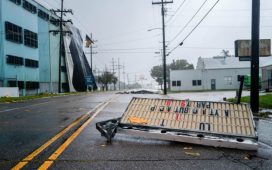This article is an on-site version of our Moral Money newsletter. Sign up here to get the newsletter sent straight to your inbox.
Visit our Moral Money hub for all the latest ESG news, opinion and analysis from around the FT
Welcome back. In today’s newsletter, I have investigated the intersection of insurance and global warming where the two are increasingly in tension: in the south-eastern US.
The situation that I detail below underscores that global warming is inflationary. For decades, we have enjoyed cheap gasoline and plastics. We saved money on those items. But now, the costs of climate change are beginning to emerge in other areas of the household budget.
Insurance isn’t the flashiest business sector. We’d all rather talk about electric vehicles or hydrogen technology. But the insurance sector is the frontline in the climate change battle, and the outlook is most definitely not getting any better. Last month was the hottest September ever and 2023 is firmly set to be the warmest year on record, the World Meteorological Organization said last week.
We don’t have a formal carbon tax in the US because the Republicans would never allow it. But there is definitely a de facto carbon tax in this country — and it is coming through the insurance market. — Patrick Temple-West
Homeowners forced to absorb costs as insurers flee south-eastern states
Farmers Insurance, one of the biggest property and casualty providers in the US, found itself under attack this year for political “wokeness”. In July, Farmers quietly pulled out of Florida amid exploding costs, prompting the state’s chief financial officer to accuse the insurer of “virtue signalling” on environmental, social and governance (ESG) issues.
“Farmers Insurance is well on its way to becoming the Bud Light of insurance,” Florida’s CFO Jimmy Patronis said, referring to the culture wars controversy that embroiled beer company Anheuser-Busch InBev earlier this year.
Snarkiness aside, the CFO’s outburst underscores the reality in the Sunshine State: it is teetering on a financial crisis. Insurance companies are fleeing Florida as costs to insure property have increased dramatically. Although governor Ron DeSantis and Florida lawmakers in 2022 tried to stem the loss of insurance coverage, the threat of hurricanes has insurance companies rushing for the exits. Six residential property and casualty insurers became insolvent in 2022, according to the state.
As a result, Florida’s state-run insurance programme, which is supposed to be an insurer of last resort, has instead become the largest insurer in the state. If the programme does not have enough funds to cover insurance claims because of hurricanes, then Florida taxpayers will need to cover the balance.
For example, if Hurricane Idalia — which hit a relatively unpopulated part of Florida in August — had hit the Tampa Bay area, the state insurer would probably not have had enough funds to cover the claims, according to a September report from the non-profit organisation First Street Foundation.

“The intensification of Hurricane Idalia prior to landfall was fueled by climate-related increases in water temperatures in the Gulf [of Mexico],” First Street said. “As the climate continues to change, the intensification of hurricane events over the gulf will become the norm and one landfall into a populated area could spell disaster for the Citizens Insurance program,” which is Florida’s state-run insurance company.
While the insurance problem is particularly acute in Florida, insurers’ costs have also increased steadily around the world. Swiss Re estimates that annual inflation-adjusted insured losses from natural catastrophes have exceeded $100bn five times since 1970, and three of those have been in the past six years, Moody’s said in a September report.
But putting a price on insurance costs due to climate change is tricky, given that it is almost impossible to “disentangle” from rising temperatures and other factors, said Marc Ragin, a professor at the University of Georgia business school.
“While climate change almost certainly plays a role in higher costs for insurance, including government-provided insurance, I would be sceptical of anyone who thinks they have a number they can attach to this,” Ragin told me.
Patronis’s punchy soundbite got attention, but the seeds of his anxiety — felt also by Florida’s 22mn residents — were on stark display at a humdrum insurance meeting with regulators at the state’s capitol in June. Citizens officials presented a troubling picture of the state’s insurance situation and asked for an average premium increase of 13 per cent.
Citizens estimated that two Category 5 hurricanes in one year could result in $23.9bn in costs. Maximum losses from a one-in-100 year storm continued to “drastically increase,” the organisation said.
“I don’t say this lightly: No one wants to pay more for insurance,” said Tim Cerio, Citizens’ president.
The problem is not isolated in Florida. In October 2022, Louisiana approved a 63 per cent rate increase on its residential property insurance policies starting this year. Louisiana, which in 2020 was hit by the highest number of storms in any hurricane season on record, has also lost private insurance companies in recent years.
The US also provides a federal flood insurance programme. This insurance won’t cover vacation homes but it does help about 1.7mn Floridians. Today, the National Flood Insurance Program is about $20bn in debt. Its losses have been amplified by floods “influenced by climate change and sea-level rise”, but also by more people living in flood-prone neighbourhoods, Firas Saleh, a director at Moody’s RMS, told me.
To mitigate these losses, the Federal Emergency Management Agency, which manages the US flood insurance programme, has established standards to withstand flooding because of climate change and avoid building in floodplains where possible, Hannah Perls, a senior staff attorney at Harvard Law School, told me. But these standards have become political: they were established by Democrat president Barack Obama, revoked by the Donald Trump administration and reinstated by President Joe Biden.
But some Floridians have another idea: cut some insurance altogether. At Florida’s insurance hearing this year, Mel Montagne, an insurance seller in the Florida Keys, said the federal government required both flood and wind insurance. But historically, the real damage from hurricanes came from wind, not flooding, he said.
“We vehemently oppose the flood insurance requirement,” Montagne said, adding that wind insurance should be the government’s only requirement.
Florida and other states in June sued the Biden administration arguing the government’s insurance coverage requirements has made protection unaffordable. At oral arguments in September, the states argued people were going to leave their homes and businesses if the federal insurance rates came into effect. The case is ongoing.
Bickering over insurance cost calculations is a distraction. What the Farmers fight and the courtroom showdown highlight is that global warming is an inflation problem — one that is falling on ordinary taxpayers. (Patrick Temple-West)
Smart read
The FT’s Jemima Kelly delivers a searing take on the trial of Sam Bankman-Fried, the founder of collapsed cryptocurrency exchange FTX. The crypto industry’s “many moral deficiencies make it a negative-sum game”, Kelly argues.










